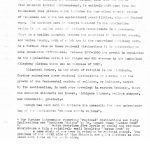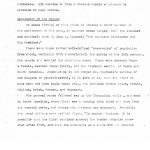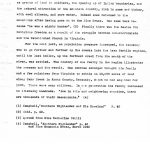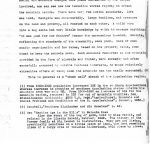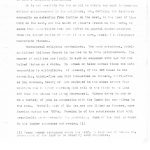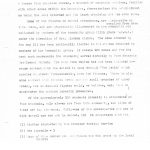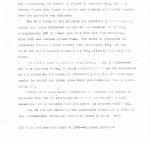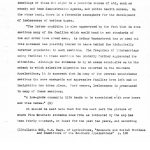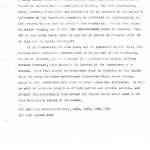Pine Mountain Settlement School
Series 07: Directors – Glyn Morris
Series 13: Education
GLYN MORRIS STUDY & RECOMMENDATIONS I SOUTHERN MOUNTAIN REGION
TAGS: Glyn Morris Study & Recommendations I Southern Mountain Region; Pine Mountain Settlement School; reflections; education; Harlan County, KY; Birdena Bishop; educational study; institutional reports; Appalachian region; topography; economics; populations; Cumberland Allegheny plateau; religion; subsistence levels; birth rates; settlers; settlement history; isolation; social standards; regions; incomes; school attendance; community evaluations; educational levels; selective migration; Evelyn K. Wells; population centers;
GALLERY: Glyn Morris Study & Recommendations I Southern Mountain Region
- morris_study_01 (03)
- morris_study_01 (04)
- morris_study_01 (05)
- morris_study_01 (06)
- morris_study_01 (07)
- morris_study_01 (08)
- morris_study_01 (09)
- morris_study_01 (10)
- morris_study_01 (11)
- morris_study_01 (12)
TRANSCRIPTION: Glyn Morris Study & Recommendations I Southern Mountain Region
[morris_study_01-03.jpg]
PART I [pp. 3-12]
THE SOUTHERN MOUNTAIN REGION
3.
An appraisal of Pine Mountain Settlement School must necessarily begin with a general consideration of the whole southern mountain region, and some mention of those characteristics largely responsible for the problems which Pine Mountain was founded to try to alleviate or help. The present brief description of the Appalachian region seeks particularly to emphasize the “regional” quality of the problem, because this seems very necessary for fuller understanding, and to avoid as far as possible the danger of generalization.
The Appalachian region is broadly defined as all of West Virginia, the western counties of Virginia, and or eastern Kentucky and Tennessee, western North Carolina, and certain portions of Northern Georgia and Alabama, together with four counties in western North Carolina. It covers an area of approximately 100,000 square miles and has a population of about 5,000,000. This area, characterized by its mountainous terrain, may, in turn, be divided into three district regions marked by definite characteristics in the topography, which in turn are reflected in the social and economic life of the inhabitants. There is the Blue Ridge belt on the east running northeast to southwest; the greater Appalachian valley in the middle, and the Cumberland-Allegheny belt on the west. The Blue Ridge belt, which includes the Smoky Mountains of North Carolina, is characterized by high mountain peaks (5000 to 6000 feet), between which are often found relatively broad and fertile valleys — quite in contrast to the narrow, less fertile valleys found between the rugged but low mountains in the Cumberland Allegheny Plateau of eastern Kentucky. The broad fertile Appalachian…
[morris_study_01-04.jpg]
4.
…valley area is in turn quite in contrast to either of the first named regions, including for example the well-known Shenandoah Valley in which may be found some of the most productive fruit orchards in America. But these regions, in turn, may be subdivided into smaller regions. For example, the plateau plainly seen from the top of Pine Mountain looking northwestward is entirely different from the table-land like plateau which includes the Cumberland country region of Tennessee and which has agricultural possibilities, although limited ones. The northern part of Georgia included in the Appalachian region is not unlike parts of northern Pennsylvania in appearance. There is a decided contrast between the mountains of Breathitt County, and Harlan County, both of which are in the Cumberland Allegheny belt. As a further clue to these regional distinctions, it is interesting to note population differences. Between 1900-1930, the growth in population in the Appalachian valleys and ridges was 43% whereas in the Cumberland Allegheny plateau there was an increase of 102%.
Elizabeth Hooker, in her study of religion in the highlands, further emphasizes these regional distinctions by showing that the growth of the Pentecostal variety of religion, or Holiness, marked by its emotionalism, is much more prevalent in eastern Kentucky, where the economic standards are lowest, birth rate highest, valleys sharper, and retardation greatest.*
Enough has been said to indicate the necessity for some understanding of the distinctive “regions within regions.”
* For further information regarding “regional” distinctions and their implications see “Southern Regions” by Dr. Howard Odum; “Hollow Folk” by [missing text: Probably refers to Mandel Sherman & Thomas R. Henry’s book Hollow Folk, published in 1933 and in reprint Berryville, VA: Virginia Book Company, 1973] which describes five levels of social and economic subsistence within a relatively small locality; “Possum Trot” by [missing text: This possibly refers to Herman Clarence Nixon’s Possum Trot Rural Community, South, published by Norman, OK: University of Oklahoma Press, 1941], a case study of one town in relation to regional change. The problems of the north side of Pine Mountain are quite distinct as compared with those on the south side.
[morris_study_01-05.jpg]
5.
The characteristics of the region as a whole are well known, and only the most casual reference to them will be made here. Difficulties in transportation are among these, as are lower subsistence levels growing out of a poor return from land which should not be farmed; inadequate taxation to support proper public services; and high birth rate. All combine to form a vicious circle which must be attacked at many points.
Settlement of the Region
It seems fitting at this point to present a brief account of the settlement of the area, an account drawn largely from the standard and scholarly work by John C. Campbell “The Southern Highlander and His Homeland.”
There were three rather well-defined “reservoirs” of population from which, beginning with approximately the middle of the 18th century, the people who settled the mountains came. These were eastern Pennsylvania, western Pennsylvania, and the Piedmont section of North and South Carolina. Although we do not forget Mr. Campbell’s warning of the dangers of generalization, it is safe to say that the first to come were not pure Anglo Saxon only, but included Scotch Irish, Scotch, English, Welsh, German, and Huguenot.
The general route followed was up the Shenandoah valley, and east to North Carolina, where there was a merging with those who came from the coastal ports, and thence the movement was westward. Naturally, the broad valleys were settled first. “In eastern Kentucky, it is possible that the first settlers entered the border counties somewhat after 1790, and that its mountains as a whole did not receive…
[morris_study_01-06.jpg]
6.
…any great influx of population until after 1800.”(1) But “even as late as the middle of the 19th century, immigrants in large number continued to travel along the mountain trails and passes.”(2) For the most part the migration was caused by pressure of population in the east, and new opportunity in the west, but there were other reasons too, such as grants of land to soldiers, the opening up of Indian boundaries, and the natural attraction of the mountain country, rich in game and timber, with cool climate, and pure water. Indeed some returned to the mountains after having gone on to the Blue Grass. One came back because “he was a mighty hunter”.(3) Finally, there was the desire for religious freedom as a result of the struggle between non-Conformists and the Established Church in Virginia.
For the most part, as population pressure increased, the tendency was to go farther and farther up the creeks into the less fertile regions, until the last hollow, up the farthest creek from the mouth of the river, was settled. The history of one family in the region illustrates the process and the result. One Ambrose Amburger brought his family and a few relatives from Virginia to settle on 10,000 acres of land along Carr Creek in Knott County, Kentucky, which he had acquired for $600. There were many children. In one generation the family increased to literally hundreds. “Now in this and neighboring counties, there are thousands of their descendants.”(4)
- Campbell, “Southern Highlander and His Homeland” P. 40.
- Ibid. P. 43.
- Quoted from Miss Katherine Pettit.
- Campbell, “Southern Highlander.” P. 45 and Pine Mountain Notes, March 1942.
[morris_study_01-07.jpg]
7.
Pressure on the land increased with each generation.(1) All travel was relatively difficult until 1850, but from 1830 to 1850 “the mountain country (Kentucky), left to provide for itself in the matter of roads, began to be shut off from the life of the remainder of the state.”(2) Keeping in mind Lord Morely’s observation that social and economic changes take place unobserved by the people involved, one can see now how isolation worked rapidly to affect the mountain people. There were very few social standards. Life was hard. Religion was otherworldly. Large families, and pressure on the land, and poverty, all reacted on each other. A child born into a log cabin had very little knowledge by which to measure anything. “It was good for our fathers” became the unconscious by-word. Schools, reflecting the standards of the community, were poor. Lack of community organization and low taxes, based on low property value, combined to keep the schools poor. Such economic resources as the mountain provided in the form of minerals and timber, were shrewdly and often wastefully garnered by outside business interests, to whose relatively attractive offers of ready cash the mountain man too easily succumbed.(3)
This, in general, is a “thumb nail” sketch of the Appalachian region.
- From 1920-1930 population increased 16% in the southern Appalachians, whereas increase in counties of southern Appalachian states outside the mountain area was only 8%. From 1900-1930 an increase of 55% for the mountain region, compared to 33% for out of mountain counties. See Miscellaneous publication #205 U.S. Dept. “Agricultural, Economic and Social Problems and Conditions of the S. Appalachians,” January 1935.)
- Campbell, “Southern Highlander and His Homeland.” P. 49.
- See “Machine Age in the Hills” by Malcolm Ross. Also, the story of the bag of gold, told by Miss Pettit and related in the Lincoln Herald, February 1942. The history of the XXX family at Big Laurel is instructive. They are not [now?] living, practically penniless on a little patch of land, the last remaining piece of a large area of valuable timberland, sold piece by piece.
[morris_study_01-08.jpg]
8.
Let us now look at the immediate area surrounding Pine Mountain Settlement School. Although no attempt has been made to make an objective study based on data which could be checked against some accepted norms, there are enough observations available from which to make a tentative evaluation.
It is not possible for the school to obtain too much information without embarrassment to its neighbors, but, defining the immediate community as extending from Incline on the west, to the head of Line Fork on the east, and the mouth of Abner’s Branch on the north, it seems that this region does not differ in general characteristics from the larger region of which it is a part, namely the Allegheny-Cumberland Plateau.
Pentecostal religions predominate. The most notorious, widely publicized Holiness Church in America is in this neighborhood. The number of children per family is 4.85 as compared with 1.8 for the United States as a whole. In normal or below normal times the main occupation is agriculture. At present, of the 126 homes in the community, thirty-five men list themselves as farmers, thirty-five as log woodmen, twenty are now employed in the mines across Pine Mountain due to labor shortage (and will be the first to be laid off when the demand for labor decreases). Others drive trucks or do a variety of jobs in connection with the lumbering operations in the area. Probably most of the men not now listed as farmers were farming during the ‘30’s. Farming is of the subsistence kind with practically no opportunity for marketing. Much of the land is owned by the lumber companies and rented.(1)
- Henry Creech estimates about one-half. A land map of Harlan Co. shows most of the land to be owned by coal companies.
[morris_study_01-09.jpg]
9.
No figures are available to us on income, but in normal times, if we accept studies made in similar regions in adjacent counties(1) it can be anywhere from $50.00 annually in cash, up, but hardly ever over a few hundred dollars. A genealogical chart compiled 1937[?] by Miss Grace Rood shows much intermarriage between a few families. A former Pine Mountain worker, a student of mountain problems, familiar with other areas within the mountains, characterizes the neighborhood as being the most retarded [backward-looking] and the least promising she has ever seen.
Some of the figures on school attendance are instructive at this point and are graphically illustrated on the community map compiled from data collected by members of the Community Group (11th-grade P.M.S.S.) under the direction of Mrs. Birdena Bishop. The area covered by the map(2) has been arbitrarily limited to the routes followed by members of the Community Group. It covers 126 homes and for the most part, represents the community served directly by Pine Mountain Settlement School. The Line Fork region has not been included because contact with the school is made through “The Cabin” which carried on almost independently, save for finance. There is also some contact with Cutshin Creek and the small branches of upper Greasy, but additional figures would, we believe, only tend to accentuate the picture herewith presented.
Of the approximately 100 students normally in attendance at Pine Mountain, only eleven are from this community, and eight of these are day students. Fifty-one of the seventy-five who are of high school age are not in school.(3) In comparison with the…
- Studies conducted by the Frontier Nursing Service.
- See Appendix – 1
- Many of this number did not finish the 8th grade in the local schools.
[morris_study_01-10.jpg]
…61% of young people up to 17[?] years of age attending school in Fayette County, or 44% in Harlan County as a whole, there are only 34% of the same age in the Pine Mountain community attending school. Of the total of 123 Pine Mountain High School graduates (1), only twelve are from the immediate community. If we include Line Fork and extend our boundaries, the number is raised to twenty-three, but this latter figure only tends to define more clearly the limited number from the school’s own backyard.
Out of a total of 481 students who enrolled in Pine Mountain during the years 1931-1940 and stayed one semester or longer, approximately 130 of these have come from the Pine Mountain, Line Fork and Bledsoe communities. The ratio of graduates to enrollees for the entire student body is roughly 1-4, but the ratio for the immediate community is 1-6, allowing liberally for error.
The real figure is probably even lower. Even if allowances are made for some error, it seems obvious that if school attendance is one criterion for community evaluation, the Pine Mountain community is behind the larger area which surrounds the Pine Mountain community.
There is no data easily available to indicate the number of children from the immediate community who did not stay a full semester. It is believed that the number is comparatively high.
All in all the following two paragraphs taken from a study of the Appalachians previously mentioned seems to apply here:…
- This includes the class of 1942 — eighteen graduates.
[morris_study_01-11.jpg]
11.
“The low educational level of the parents in the poorer families, limited contacts and limited reading, scarcity of recreational outlets, together with unattractive physical surroundings — except for the mountain scenery — make for an uninspiring home atmosphere, lack of initiative, and narrowness of outlook. Thus there is an unfriendly soil for the teachings of those who might be a possible source of aid, such as county and home demonstration agents, and public health nurses. On the other hand, there is a favorable atmosphere for the development of lawlessness of various types.
“The latter condition is also aggravated by the fact that in some sections many of the families which would tend to set standards of law and order have moved away. As Arthur Esterbrook has pointed out this movement has possibly tended to leave behind the biologically inferior population in such sections.* The frequency of intermarriage among families in these sections has probably further aggravated the situation. [See note below] Although the evidence is by no means conclusive as to the extent to which selective migration has occurred in the Southern Appalachians, it is apparent that in many of the poorest mountainous sections the more energetic and aggressive families have left and no immigration has taken place. Furthermore, lawlessness is pronounced in many of these sections.
“A low-grade community life tends to be associated with poor homes and vice versa.”(1)
It should be said here that for the most part the picture of where Pine Mountain students come from as indicated by the map has been fairly constant, at least for the past ten years, and according…
- Bulletin 205, U.S. Dept. of Agriculture, “Economic and Social Problems and Conditions of the Southern Appalachians.” P. 162. [Morris cites Esterbrooke, Arthur H. but fails to note that the quotation is taken from the 1928 article in Mountain Life and Work, V.4, no.2, pp5-13, 35-36, “Is there a Mountain Problem?” which has some profound errors associated with the eugenics promotion of Esterbrook. This sociological mis-direction has largely been discredited by the work of later sociologists. See” David S. Walls and Dwight B. Billings, “The Sociology of Southern Appalachia.” Appalachian Journal Vol. 5 no. 1. Fall 1977 and remains deeply offensive to many.]
12.
…to Miss [Evelyn K.] Wells’ history, probably true from the very beginning. Pine Mountain’s student body has come largely from localities at some distance from the school.(1)
In examining the map you will notice that there is some tendency towards grouping, and that students come from around population centers. A large number come from broken homes. Over half would find it difficult or impossible to attend public school. The most outstanding fact, however, which this map points out is the absence of the school’s influence in its immediate community as indicated by participation in its program on the part of youth of the community. Within four miles is Leslie County, one of the most impoverished areas in America. Only 13% of its youth 14-15 years of age are in school as compared with 72% of like age in Harlan County.(2)
It is interesting to note also, and to speculate on the fact, that whereas most population centers tend to be located at the converging points of streams, and that travel in the mountains usually follows streams downward, Pine Mountain is located at the headwaters of a stream. This fact should be remembered also in relation to the manner in which early settlers established themselves along water routes, going to the headwaters only when no other place was available. It will be well to note the locations of both public and private schools, and project imaginatively a line around the region which would seem to be Pine Mountain’s sphere of influence.
- See Pine Mountain History, 1921, 1923, 1925, 1927.
U.S. Census 1940.
See Also:
GLYN MORRIS Biography
GLYN MORRIS STUDY & RECOMMENDATIONS [FOR PMSS] 1942


